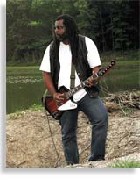
Alvin YoungBlood Hart brings the rock! His new album, Motivational Speaker, is a tough, guitar-driven blend of ’70s blues-rock, classic country, and sumptuous slide guitar. Moving beyond the core audience that praised him for channeling Charlie Patton, Ledbelly, and Skip James, Hart is a multifaceted guitarist who is true to himself and his artistic vision. He’s a badass guitar player with chops galore, tone for days and his own special mojo when it comes to fixing his amplifier.
Vintage Guitar: Was there a concept behind Motivational Speaker?
Alvin Youngblood Hart: It’s just what was coming out of me. A lot of things I do are tributary – paying back the inspiration and stuff like that. As far as the guitar in my life, in general, it always brings me back to a certain time. When I was 17, I was really inspired and just hung on the guitar all the time. And I was hanging around kids who were just as passionate. We were listening to everything from Sly Stone to Leadbelly to Thin Lizzy, Humble Pie, Ray Charles, and Johnny Cash.
Is it problematic having so many diverse influences?
No problem at all. It’s part of the same fraternity. Everybody had that moment in life where they sat down and it hit them. Everybody else, I guess, has that issue. I don’t. I don’t even think about it. So much time has passed that I kind of left all that behind. My records and live shows are what would be going on if I was sitting around the house listening to records.
You’re not concerned with alienating those who want you to sit on the front porch and whip out the acoustic?
No, man, they need alienating [laughs]. I’m going to do it when I want to do it, and not when I’m told to do it. Nowdays you have to be a songwriter, and that was something I never really aspired to. I just wanted to be a guitar player. As things changed I had to become a songwriter. I’m definitely not going to sit there and write the same old Charlie Patton tune over and over again.
I’ve got different avenues of inspiration that keep me going, and one of them is that I’m a pretty fair tube-amp mechanic. Amps are just as responsible for bringing out a song. Growing up being into Jimmy Page, I always thought he had mastered both worlds, electric and acoustic. That’s what pushed me in that direction.
What kind of gear did you use to make the record?
I’m a big proponent of playing pickups. I started winding them when I was about 15, so I have a pretty good understanding. I played different pickups for different sounds, basically through just one amp – a ’71 Marshall Trem 50. On one slide part I used a silverface Fender Champ that I tweeded up. For guitars, I used an ’80s Les Paul Custom with DiMarzio PAFs. In high school, I’d read interviews where Van Halen would say stuff like, “DiMarzio pickups are too distorted.” So all these dudes I knew would be ripping DiMarzios out of their guitars and I’d get them for $5 or $10 [laughs]. He’d say, “Bigsbys are the worst,” so I’d get a Bigsby for 25 bucks or something. I used a mid-’70s Tele for all the clean and country stuff, some Danelectros for the open-tuned things, and a Silvertone Jimmy Reed Thin Twin.
Any stompboxes? Your dirty sound is ferocious.
Most of that is the amp. Plus, I blew a speaker and left it in [laughs]. I’m a disciple of Link Wray, who they claimed poked holes in his speaker with a pencil, so I left the speaker in the cabinet. On some of the slide solos there’s a box I made called the Blow Drive, and sometimes I use a DOD 250. Another box I use is called a Pro Mark II, which was based on the old Sola Sound Tonebender. But most of it was the amp.
What do you say to people who come up you at gigs and say, “Play some Leadbelly” [laughs]?
I just tell ’em you’re at the wrong gig. Come to the solo gig. Enjoy yourself, but if you’re not into it don’t be comin’ in here lemon suckin’. Remember that on “Captain Kangaroo” [laughs]?
Read more about Hart at alvinyoungbloodhart.net.
Above Photo: Butch Ruth, courtesy Tone Cool Records.
This article originally appeared in VG‘s Feb. ’06 issue. All copyrights are by the author and Vintage Guitar magazine. Unauthorized replication or use is strictly prohibited.



